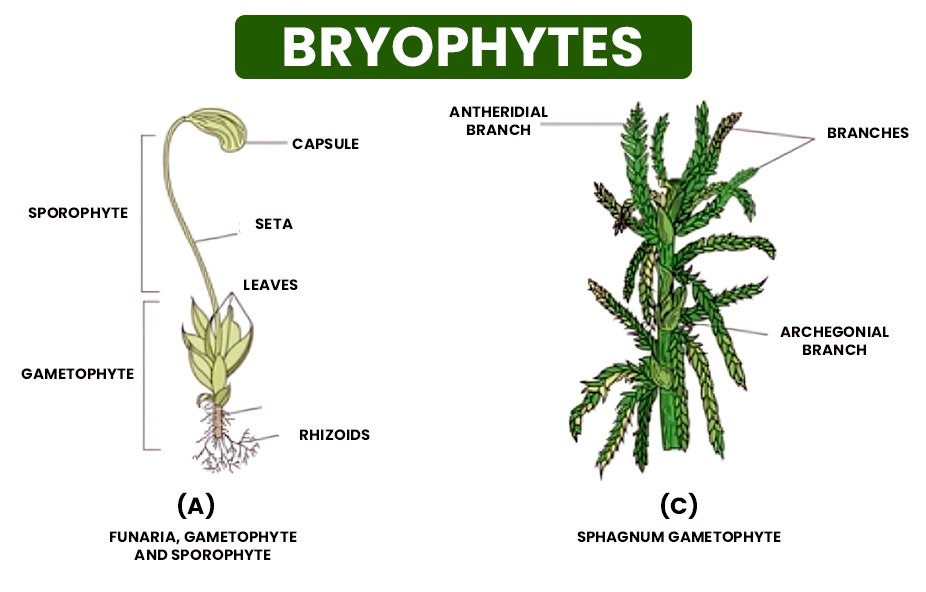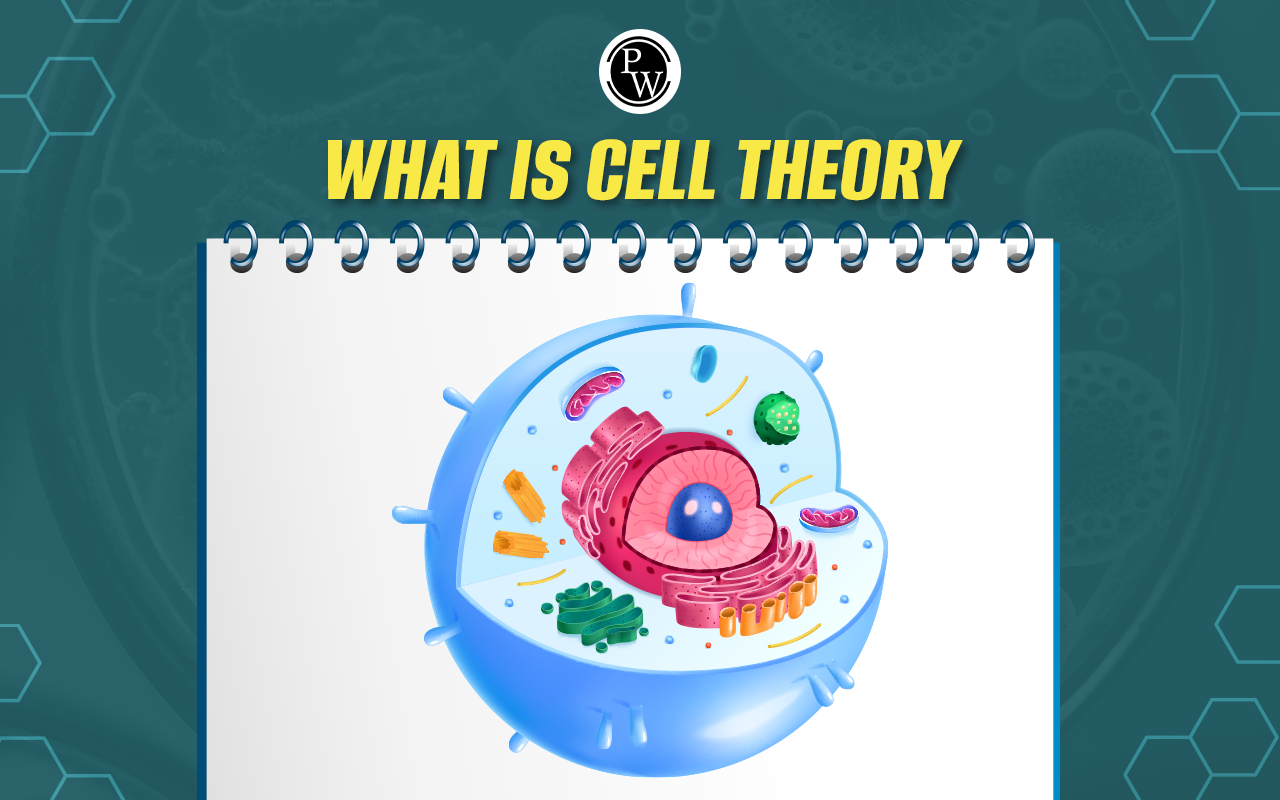
Sphagnum: Sphagnum, also known as peat moss, sphagnum moss, or bog moss, is a genus of mosses with approximately 380 accepted species. These mosses are ecologically significant because they produce peat moss, which acts as a carbon sink in the ecosystem. Sphagnum thrives in wet, boggy environments and requires acidic soil conditions. Sphagnum is notable for its ability to store large amounts of water, with both living and dead plants retaining 16 to 26 times their dry weight, depending on the species. Detailed NEET Biology notes on Sphagnum are provided in the article below.
Sphagnum Diagram
Sphagnum diagram is as follows:
Sphagnum Classification
Sphagnum moss is an important component of bogs and fens, forming peat that acts as a carbon sink in the ecosystem. Sphagnum thrives in wet, boggy areas and is well suited to acidic soil conditions. This genus contains about 380 accepted species, also known as sphagnum, peat, and bog moss. Sphagnum is classified as follows:| Sphagnum Classification | |
|---|---|
| Category | Classification |
| Kingdom | Plantae |
| Division | Bryophyta (mosses) |
| Class | Sphagnopsida |
| Order | Sphagnales |
| Family | Sphagnaceae |
| Genus | Sphagnum L. |
Sphagnum Structure
Sphagnum moss thrives in wet, acidic environments due to its unique structure. The structure of Sphagnum can be studied in two important phases: gametophyte and reproductive.Gametophyte (Dominant Phase)
This is the visible, leafy green part of the sphagnum moss plant. Individual plants can exceed 30 cm in length, though the green portion is usually 10 cm or less. The gametophyte consists of a main stem with branches that cluster near the top, giving it a feathery or star-shaped appearance. 1. Stem:- Pith: The inner core responsible for food production and storage.
- Cortical Layer: The outer layer containing specialized cells for water absorption and protection. Sphagnum moss lacks a vascular system, so its tissues are typically one cell thick to facilitate diffusion.
- Chlorophyllose Cells: Small, green, living cells with chlorophyll that produce food through photosynthesis.
- Hyaline Cells: Large, dead, empty cells without chlorophyll, with perforated walls that allow the plant to hold water up to 30 times its dry weight. This water-holding capacity is crucial for survival in bogs and waterlogged habitats.
Structural Organisation in Animals
Sporophyte (Reproductive Phase)
The sporophyte is smaller and shorter-lived compared to the gametophyte. It grows on the female branch of the gametophyte and produces spores for reproduction. Sporophyte Structure of sphagnum is as follows:- Capsule: The spore-bearing structure, consisting of a central columella surrounded by a spore sac and a protective outer wall. The capsule is covered by a disc-shaped lid (operculum), which pops off to release spores for dispersal.
Sphagnum Characteristics
The following are the detailed characteristics of Sphagnum, also known as sphagnum moss or peat moss:- Water Retention: Sphagnum moss can retain large amounts of water, up to 20 times its dry weight, due to its specialized cells known as hyaline cells.
- Acidic Environment: It creates an acidic environment by releasing organic acids, which lower the pH of the surrounding water and soil.
- Peat Formation: As Sphagnum decomposes, it forms peat, a dense, waterlogged layer that builds up over time and captures carbon.
- Growth Form: Sphagnum grows in thick mats or cushions. The older parts decompose into peat while the upper parts remain alive.
- Leaf Structure: The leaves contain large, empty hyaline cells for water retention and smaller chlorophyllose cells for photosynthesis.
- Reproduction: It mainly reproduces asexually through fragmentation but also reproduces sexually by producing spores.
- Habitat: Sphagnum moss is commonly found in bogs, fens, and wetlands, thriving in cool and moist environments.
- Color: The color of Sphagnum moss varies from green to red, depending on the species and environmental conditions.
- Global Distribution: Sphagnum moss is found worldwide, particularly abundant in the Northern Hemisphere's boreal and temperate regions.
- Ecological Role: It plays a crucial role in storing carbon and maintaining wetland ecosystems.
| Important NEET Biology Notes | ||
|---|---|---|
| Selaginella | Embryo | Malvaceae |
| Pinus | Polyembryony | Volvox |
Sphagnum Uses
Sphagnum, or peat moss, has various uses due to its unique properties:- Soil Amendment: Improves soil structure by retaining water and nutrients.
- Seed Starting and Growing Medium: Ideal for starting seeds and cultivating plants like orchids.
- Carbon Sequestration: Sphagnum bogs trap CO2, aiding in climate change mitigation.
- Habitat Creation: Supports diverse ecosystems in peatlands and bogs.
- Packaging Material: Cushions and regulates moisture.
- Preservation : Used to preserve food and biological specimens.
- Floral Arrangements: Retains moisture and adds natural beauty.
- Craft Projects: Used in terrariums and model landscapes.
- Bedding Material: Soft and insulating.
- Construction: Peat used in traditional building materials.
| Important NEET Biology Notes | ||
|---|---|---|
| Chara | Funaria | Apomixis |
| Rhizopus | Spirogyra | Bacteriophage |
Sphagnum Reproduction
Sphagnum, also known as peat moss, has distinctive reproductive strategies that enable it to thrive in wetlands and bogs. Sphagnum reproduces through two methods: vegetative and sexual reproduction.Vegetative Reproduction
Fragmentation: Sphagnum primarily reproduces vegetatively through fragmentation. When parts of the moss break off, they can grow into new individuals. This process allows Sphagnum to spread and colonize wetlands and bogs.Sexual Reproduction
1. Gametophyte Formation:- The gametophyte stage is the dominant phase in Sphagnum's life cycle.
- It includes the juvenile protonema (initial growth) and the leafy gametophore (mature stage).
- Young gametophytes have multicellular rhizoids, but mature ones do not.
- The main stem becomes upright and thick, with many branches.
- Leaves are small, sessile, and lack a distinct midrib.
- Antheridia develop on specialized male branches.
- They are club-shaped, with a long multicellular stalk and a globular body.
- Inside the antheridium, androgonial cells develop into spirally coiled sperm with flagella.
- Archegonia grow on specialized female branches.
- They are flask-shaped, with a swollen neck and a long twisted venter.
- The neck has six vertical layers of neck cells and cover cells.
- The venter contains a ventral canal cell and a basal egg cell.
- Fertilization occurs in the presence of water.
- Sperm cells swim up to the archegonia.
- The neck canal cells and ventral canal cells disorganize to form a passage for sperm entry.
- The sperm reaches the egg cell, resulting in the formation of a diploid zygote.
Sphagnum Life Cycle
The life cycle of Sphagnum moss features an alternation of generations, similar to other land plants. However, in Sphagnum, the haploid gametophyte generation is dominant and long-lasting. This means the leafy green stage of the moss is the most visible in bogs and marshes.- Spores: The cycle starts with spores produced in capsules on the diploid sporophyte. These spores are dispersed by wind or water.
- Protonema: When spores land in a moist environment, they germinate into a filamentous protonema. This stage is short-lived but essential for developing the next phase.
- Gametophore: Buds on the protonema grow into the leafy gametophore, the familiar green moss plant. Unlike other mosses, mature gametophores of Sphagnum lack rhizoids and absorb water directly through their leaves.
- Sexual Reproduction: Sphagnum can be unisexual (separate male and female plants) or bisexual (both male and female organs on one plant). Fertilization occurs when a sperm from the antheridium (male organ) reaches an egg in the archegonium (female organ).
- Sporophyte: Fertilization forms a diploid sporophyte, which relies on the gametophore for nutrition. It develops in the capsule on the archegonium of the gametophore.
- Spore Release: The sporophyte matures, undergoes meiosis, and produces haploid spores. The capsule splits, releasing the spores to begin the cycle again.
| NEET Exam Important Links | |
|---|---|
| NEET Biology Syllabus | NEET Biology Diagrams |
| NEET Biology MCQ | NEET Biology Chapter wise Weightage |
| NEET Biology Notes | NEET Previous Year Question papers |
title='Sphagnum FAQs
Q 1. What is sphagnum used for?
Ans. Sphagnum peat moss is commonly utilized to enhance soil drainage and aeration. It is also employed as a lining for hanging planters and in various crafts and floral arrangements.
Q 2. Is sphagnum a bryophyte?
Ans. Yes, Sphagnum is a bryophyte of significant economic importance. It is known as sphagnum moss or peat moss and is notable for acidifying its environment to inhibit bacterial and fungal growth.
Q 3. What are the functions of sphagnum?
Ans. Decayed and dried sphagnum moss, known as peat or peat moss, serves as a soil conditioner. It enhances soil water retention and nutrient holding capacity through increased capillary forces and cation exchange capacity, making it particularly beneficial for gardening.
Q 4. Is sphagnum used as medicine?
Ans. Yes, sphagnum moss, specifically the active substance Sphagnol found in the genus Sphagnum, is used in treating various conditions such as acne, hemorrhoids, and skin diseases. Its antimicrobial properties are also applied in different medical and industrial fields.
🔥 Trending Blogs
Talk to a counsellorHave doubts? Our support team will be happy to assist you!

Free Learning Resources
PW Books
Notes (Class 10-12)
PW Study Materials
Notes (Class 6-9)
Ncert Solutions
Govt Exams
Class 6th to 12th Online Courses
Govt Job Exams Courses
UPSC Coaching
Defence Exam Coaching
Gate Exam Coaching
Other Exams
Know about Physics Wallah
Physics Wallah is an Indian edtech platform that provides accessible & comprehensive learning experiences to students from Class 6th to postgraduate level. We also provide extensive NCERT solutions, sample paper, NEET, JEE Mains, BITSAT previous year papers & more such resources to students. Physics Wallah also caters to over 3.5 million registered students and over 78 lakh+ Youtube subscribers with 4.8 rating on its app.
We Stand Out because
We provide students with intensive courses with India’s qualified & experienced faculties & mentors. PW strives to make the learning experience comprehensive and accessible for students of all sections of society. We believe in empowering every single student who couldn't dream of a good career in engineering and medical field earlier.
Our Key Focus Areas
Physics Wallah's main focus is to make the learning experience as economical as possible for all students. With our affordable courses like Lakshya, Udaan and Arjuna and many others, we have been able to provide a platform for lakhs of aspirants. From providing Chemistry, Maths, Physics formula to giving e-books of eminent authors like RD Sharma, RS Aggarwal and Lakhmir Singh, PW focuses on every single student's need for preparation.
What Makes Us Different
Physics Wallah strives to develop a comprehensive pedagogical structure for students, where they get a state-of-the-art learning experience with study material and resources. Apart from catering students preparing for JEE Mains and NEET, PW also provides study material for each state board like Uttar Pradesh, Bihar, and others
Copyright © 2025 Physicswallah Limited All rights reserved.
Get App









